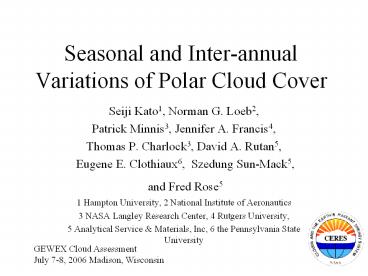Seasonal and Inter-annual Variations of Polar Cloud Cover - PowerPoint PPT Presentation
1 / 22
Title:
Seasonal and Inter-annual Variations of Polar Cloud Cover
Description:
Seasonal and Inter-annual Variations of Polar Cloud Cover. Seiji Kato1, Norman G. Loeb2, ... Thomas P. Charlock3, David A. Rutan5, Eugene E. Clothiaux6, ... – PowerPoint PPT presentation
Number of Views:24
Avg rating:3.0/5.0
Title: Seasonal and Inter-annual Variations of Polar Cloud Cover
1
Seasonal and Inter-annual Variations of Polar
Cloud Cover
- Seiji Kato1, Norman G. Loeb2,
- Patrick Minnis3, Jennifer A. Francis4,
- Thomas P. Charlock3, David A. Rutan5,
- Eugene E. Clothiaux6, Szedung Sun-Mack5,
- and Fred Rose5
- 1 Hampton University, 2 National Institute of
Aeronautics - 3 NASA Langley Research Center, 4 Rutgers
University, - 5 Analytical Service Materials, Inc, 6 the
Pennsylvania State University
GEWEX Cloud Assessment July 7-8, 2006 Madison,
Wisconsin
2
Outline
- Comparison of cloud fraction over the Arctic
(60N-90N)and Antarctic (60S-90S). - Comparison with ground-based data.
- Consistency check of cloud detection using CERES
multi-angle observations. - Cloud and radiation trend over the Arctic.
3
Data
- Terra SSF Ed2B_Rev1 from March 2000 through Feb.
2004 and Aqua Ed1B from Aug.2002 through Feb.
2004. - TOVS cloud retrieval from J. Francis
- MODIS collection4.
- ISCCP (D2).
- Area-weighted mean values over the Arctic
(60-90N) and over the Antarctic (60-90S).
4
Seasonal Variations, Cloud Cover
Arctic
Antarctic
Snow/Sea ice
Snow/Sea ice
5
Seasonal variation Clouds over Ocean and Land
Day Night
CERES ed2B and MODIS collection 4
6
Antarctic
Retrieved from MODIS radiances by the CERES cloud
algorithm
7
Summary Seasonal Cloud Variation
- The cloud fraction from MODIS over the Arctic
changes from 0.8 In summer to 0.5 In winter. - The cloud fraction over land and ocean in the
Arctic show a similar seasonal variation. - The cloud fraction over the Antarctic does not
show much seasonal variations. - A larger difference in the winter cloud fraction
than the summer cloud fraction (less than 10).
8
Comparison with Cloud Occurrence Derived from
Ground-based Active Sensors
Day Night clouds over Barrow, AK
March 2000 Feb. 2004
CERES CERES cloud
algorithm Radar Millimeter Cloud
Radar Lasers micro-pulse lidar
Vaisala celometer
9
Large differences in Radar and Laser-based Cloud
Occurrence
10
Smaller Difference in Cloud Occurrence
Clear day
11
Cloud Vertical Profile Daytime
Barrow, AK
12
Cloud Vertical Profile, Nighttime
13
Seasonal Cloud Cover over Barrow, AK(March 2000
Feb. 2004)
Day Day Night Night DayNight DayNight
MMCR () CERES () MMCR () CERES () MMCR () CERES ()
Spring 64 66 64 46 64 61
Summer 81 81 81 89 81 81
Fall 91 85 87 72 88 77
Winter 58 55 52 47 54 48
14
Comparison with LW anomaly
Barrow CERES
Correlation coefficient 0.57
NyAlesund (Norway) CERES
Correlation coefficient 0.40
Solid circle Cloud Open square
Downward longwave
15
Nighttime Cloud Cover over Antarctica
16
Terra-Aqua CERES Cloud Algorithm Difference
Aqua detection has more Colder clear-sky scenes
17
CERES-MODIS collocation
MODIS pixels
CERES footprint
Clear scenes can be viewed from different angles
by CERES
18
Nighttime Longwave over Antarctica
19
Daytime Trends Over the Arctic
2.02.0 W m-2
0.0470.041
(0.016 Summer 0.033 Spring by Wang and
Key, J. Climate, 2005)
-0.0640.055
At a 80 confidence level
20
Cloud trend over Barrow derived from lidars
From March 2000 through Feb. 2004
21
Cloud trend between March 2000-Feb. 2004
Day
Day Night
22
Summary
- The cloud fraction over the Arctic changes from
0.8 in summer to 0.5 in winter. - The cloud fractions over land and ocean in the
Arctic show a similar seasonal variation. - The cloud fraction over the Antarctic does not
show a large seasonal variation. - A larger difference in the winter cloud fraction
than the summer cloud fraction (less than 10). - The range of optical thickness has to defined for
polar cloud fraction comparison. - The daytime cloud fraction over the Arctic from
March 2000 through February 2004 increased at a
rate of 0.047 decade. - The corresponding top-of-atmosphere (TOA)
shortwave irradiances decreases at a rate of 2W
m-2, but the trend is less statistically
significant. - The cloud fraction and TOA shortwave irradiance
over the Antarctic show no significant trend
during the same period.































